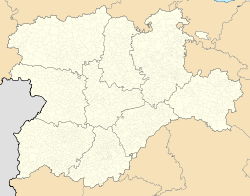| This article needs additional citations for verification. Please help improve this article by adding citations to reliable sources. Unsourced material may be challenged and removed. Find sources: "Arévalo" – news · newspapers · books · scholar · JSTOR (September 2013) (Learn how and when to remove this message) |
| Arévalo | |
|---|---|
| municipality | |
    1) Castle of Arévalo; 2) Church of San Martín; 3) Partial view of Arévalo; 4) View of the main square. 1) Castle of Arévalo; 2) Church of San Martín; 3) Partial view of Arévalo; 4) View of the main square. | |
 Flag Flag Coat of arms Coat of arms | |
  | |
| Coordinates: 41°4′0″N 4°43′0″W / 41.06667°N 4.71667°W / 41.06667; -4.71667 | |
| Country | |
| Autonomous community | |
| Province | |
| Area | |
| • Total | 46.07 km (17.79 sq mi) |
| Elevation | 820 m (2,690 ft) |
| Population | |
| • Total | 8,069 |
| • Density | 180/km (450/sq mi) |
| Website | Official website |
Arévalo is a municipality in Spain, it is situated in the province of Ávila and is part of the autonomous community of Castile and León. The name came from the Celtic word arevalon, meaning "place near the wall."
Regional importance
The city is the capital of La Moraña. Queen Isabella I of Castile was raised here as a young girl. The government of Spain has declared this city a Historic-Artistic (more important than Soria) site due to its many examples of Mudéjar art.
History
The city is the hometown and birthplace of an author simply known as the Young Man of Arévalo, one of the most famous known crypto-Muslim authors after the forced conversions of Muslims in Spain.
Location and population
It is located at an altitude of 820 meters and is near the junction of the two rivers Adaja and Arevalillo. Its encompassed area is 46.07 km and its population is 13.122. In medieval times, it was the head of the agricultural sector (Comunidad de Villa y Tierra) of the same name.
Monuments

- La Muralla. The city walls, of which only the north part can be appreciated, as the east part is practically destroyed. It is currently being restored. They originally had five doors and formed a triangle with the castle in its superior vertex. The two sides of the triangle are formed by the rivers Arevalillo and Adaja. The base of the triangle was protected by a double wall and a pit.
- The parish church of Santo Domingo de Silos.
- The church of San Juan.
- The church of Santa María whose tower is crossed by the street of the same name.
- The church of San Miguel which possesses a great collection of works of art.
- The church of San Martín or the Torres Gemelas (Twin Towers). Formerly a mosque, it conserves a peculiar style.
- The church of El Salvador (The Savior) in which the floats for the Easter processions are kept.
In addition to this there are many other brick monuments from different eras. The palace of the Gutiérrez de Altamirano, the house of the militia, the palace of Cárdenas, the palace of río Ungria, the palace of Real, the palace of Ballesteros Ronquillo, the palace of Sedeño and the palace of general Vicente del Río. There are also diverse convents, the castle in which the Museum of Cereal is located, plaza del Arrabal, plaza Del Real, plaza de San Pedro and plaza de la Villa.
See also: Medina BridgeCommuting

The highway A-6 unites Madrid with La Coruña and some of the population uses this transit system to commute to the main cities of the northwest peninsula.
Also the train line Madrid-Hendaya has a stop in this town. From this line, the town is communicated thanks to its numerous regional trains with cities such as Madrid, Ávila, Medina del Campo, Valladolid, Burgos, Palencia, Vitoria and Santander.
Economy
Farming, cattle ranching, lumber industry, a small but powerful industrial sector and other businesses which are fundamentally based upon the processing of agriculture are the main forms of employment.
Education
There are 3 schools, C.P. La Moraña, C.P. Los Arevacos and el Amor de Dios, which operate in this district. Additionally there are 3 centers for secondary education, Los Salesianos, I.E.S Adaja y I.E.S Eulogio Florentino Sanz.
Places of interest

In addition, Arévalo has other places of interest like la formidable Avenida Emilio Romero, a sports facility, a new bridge constructed , the plaza of the villa, (in Spanish, Plaza de la Villa), the municipal library, the museum of el cereal, the history of Arévalo museum, the nature center in la Plaza del Real, and the Tuesday market in the fairground.
Traditions of the town of Arévalo and festivals
Festivals
Arévalo celebrates the festival of its patron saint San Victorino on 7 July, with its traditional parade of cabezudos, the opening of its fairground, and bullfights in the town's streets. The festivals conclude with fireworks from the castle until 11pm.
Sister City
External links
References
- Municipal Register of Spain 2018. National Statistics Institute.
- "Arévalo". TURESPAÑA. Archived from the original on 2007-09-29. Retrieved 2007-05-25.
- Harvey, L. P. (2005). Muslims in Spain, 1500 to 1614. University of Chicago Press. p. 170. ISBN 978-0-226-31963-6.